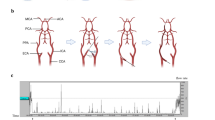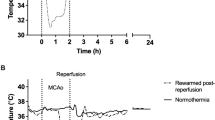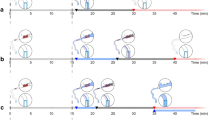Abstract
The post-thrombotic brain has recently been reported to have an enhanced vulnerability to a second embolic insult. Although postischemic hypothermia is neuroprotective in global and focal ischemia models, the effect of mild hypothermia on outcome after thromboembolic insults has not been evaluated. This study therefore determined whether brain hypothermia (33°C) was neuroprotective against repeated thromboembolic insults. Photochemically induced non-occlusive common carotid artery thrombosis (CCAT) leading to platelet embolization to the brain was induced in anesthetized rats (n=35). Thirty minutes after CCAT, brain temperature was maintained at normothermic (37°C) or hypothermic (33°C) levels for 4 h followed by a slow rewarming period (1.5 h). Three days later, rats underwent a secondary CCAT insult under normothermic conditions and were allowed to survive for an additional 3 days prior to perfusion fixation and quantitative histopathological assessment. Compared to normothermic animals, mild hypothermia after the first embolic insult produced a significant reduction (P>0.05) in overall infarct volume. Hypothermia reduced total infarct volume from 7.55±2.32 mm3 (mean ± SEM) in normothermic rats to 2.56±0.88 mm3 in hypothermic animals undergoing repeated insults. Histopathological analysis also demonstrated less evidence for focal hemorrhage in the cooled groups. These data demonstrate that mild hypothermia is protective in a thromboembolic stroke model. In addition, post-thrombotic hypothermia decreases the histopathological vulnerability of the post-thrombotic brain to secondary embolic insults. These findings may be important in the prevention of stroke in patients at risk.




Similar content being viewed by others
References
Albers GW, Caplan LR, Easton JD, Fayad PB, Mohr JP, Saver JL, Sherman DG (2002) Transient ischemic attack—proposal for a new definition. N Engl J Med 347:1713–1716
Asahi M, Asahi K, Jung JC, Zoppo GJ del, Fini ME, Lo EHS (2000) Role for matrix metalloproteinase 9 after focal cerebral ischemia: effects of gene knockout and enzyme inhibition with BB-94. J Cereb Blood Flow Metab 20:1681–1689
Barone FC, Feuerstein GZ, White RF (1997) Brain cooling during transient focal ischemia provides complete neuroprotection. Neurosci Biobehav Rev 21:31–44
Bernard SA, Gray TW, Buist MD, Jones BM, Silvester W, Gutteridge G, Smith K (2002) Treatment of comatose survivors of out-of-hospital cardiac arrest with induced hypothermia. N Engl J Med 346:557–563
Birkedal-Hansen H, Moore WG, Bodden MK, Windsor LJ, Birkedal-Hansen B, DeCarlo A, Engler JA (1993) Matrix metalloproteinases: a review. Crit Rev Oral Biol Med 4:197–250
Busto R, Dietrich WD, Globus MY-T, Valdes I, Scheinberg P, Ginsberg MD (1987) Small differences in intraischemic brain temperature critically determine the extent of ischemic neuronal injury. J Cereb Blood Flow Metab 7:729–738
Cerebral Embolism Task Force (1986) Cardiac brain embolism. Arch Neurol 43:71–84
Chen JC, Simon R (1997) Ischemic tolerance in the brain. Neurology 48:306–311
Colbourne F, Li H, Buchan AM (1999) Indefatigable CA1 sector neuroprotection with mild hypothermia induced 6 hours after severe forebrain ischemia in rats. J Cereb Blood Flow Metab 198:742–749
Colbourne F, Sutherland GR, Corbett D (1997) Postischemic hypothermia. A critical appraisal with implications for clinical treatment. Mol Neurobiol 14:171–201
Danton GH, Prado R, Truettner J, Watson BD, Dietrich WD (2002) Endothelial nitric oxide synthase pathophysiology after nonocclusive common carotid artery thrombosis in rats. J Cereb Blood Flow Metab 22:612–619
Danton GH, Prado R, Watson BD, Dietrich WD (2002) Temporal profile of enhanced vulnerability of the postthrombotic brain to secondary embolic events. Stroke 33:1113–1119
Del Zoppo GJ (1997) Microvascular responses to cerebral ischemia/inflammation. Ann NY Acad Sci 823:132–147
Del Zoppo GJ, Hallenback JM (2000) Advances in the vascular pathophysiology of ischemic stroke. Thromb Res 98:73–81
Dietrich WD, Busto R, Halley M, Valdes I (1990) The importance of brain temperature in alterations of the blood-brain barrier following brain ischemia. J Neuropathol Exp Neurol 49:486–497
Dietrich WD, Busto R, Alonso O, Globus MY-T, Ginsberg MD (1993) Intraischemic but not postischemic brain hypothermia protects chronically following global forebrain ischemia in rats. J Cereb Blood Flow Metab 13:541–549
Dietrich WD, Prado R, Halley M, Watson BD (1993) Microvascular and neuronal consequences of common carotid artery thrombosis and platelet embolization in rats. J Neuropathol Exp Neurol 52:351–360
Dietrich WD, Busto R, Globus MY, Ginsberg MD (1996) Brain damage and temperature: cellular and molecular mechanisms. Adv Neurol 71:177–194
Dietrich WD, Prado R, Pravia C, Zhao W, Ginsberg MD, Watson BD (1999) Delayed hypovolemic hypotension exacerbates the hemodynamic and histopathologic consequences of thromboembolic stroke in rats. J Cereb Blood Flow Metab 19:918–926
Dietrich WD, Truettner J, Prado R, Stagliano NE, Zhao W, Busto R, Ginsberg MD, Watson BD (2000) Thromboembolic events lead to cortical spreading depression and expression of c-fos, brain-derived neurotrophic factor, glial fibrillary acidic protein, and heat shock protein 70 mRNA in rats. J Cereb Blood Flow Metab 20:103–111
Dirnagl U, Simon RP, Hallenbeck JM (2003) Ischemic tolerance and endogenous neuroprotection. Trends Neurosci 26:248–254
Fisher M (1999) Neuroprotection of acute ischemic stroke: where are we? Neuroscientist 5:392–401
Futrell N, Watson BD, Dietrich WD, Prado R, Millikan C, Ginsberg MD (1988) A new model of embolic stroke produced by photochemical injury to the carotid artery in the rat. Ann Neurol 23:251–257
Gladstone DJ, Black SE, Hakim AM (2002) Toward wisdom from failure. Lessens from neuroprotective stroke trials and new therapeutic directions. Stroke 33:2123–2136
Hakim AM (1994) Could transient ischemic attacks have a cerebroprotective role? Stroke 25:715–717
Heo JH, Lucero J, Abumiya T, Koziol JA, Copeland BR, Zoppo GJ del (1999) Matrix metalloproteinases increase very early during experimental focal cerebral ischemia. J Cereb Blood Flow Metab 19:624–633
Huang Z G, Xue D, Preston E, Karbalai H, Buchan AM (1999) Biphasic opening of the blood-brain barrier following transient focal ischemia: effects of hypothermia. Can J Neurol Sci 236:298–304
Inamasu J, Suga S, Sato S, Horiguchi T, Akaji K, Mayanagi K. Kawase T (2000) Postischemic hypothermia delayed neutrophil accumulation and microglial activation following transient focal ischemia in rats. J Neuroimmunol 109:55–74
Johnston SC (2002) Clinical practice. Transient ischemic attack. N Engl J Med 347:1687–1692
Johnston SJ, Gress DR, Browner WS, Sidney S (2000) Short-term prognosis after emergency-department diagnosis of TIA. JAMA 284:2901–2906
Kidwell CS, Alger JR, Di Salle F, Starkman S, Villablanca P, Bentson J, Saver JL (2001) Diffusion MRI in patients with transient ischemic attacks. Stroke 30:1174–1180
Kidwell CS, Liebeskind DS, Starkman S, Saver JL (2001) Trends in acute ischemic stroke trials through the 20th century. Stroke 32:1349–1359
Kinoshita K, Chatzipanteli K, Alonso OF, Howard M, Dietrich WD (2002) The effect of brain temperature on hemoglobin extravasation after traumatic brain injury. J Neurosurg 97:945–953
Krieger D, De Georgia M, Abou-Chebl A, Andrefsky J, Sila C, Katzan I, Mayberg MR, Furlan A (2001) Cooling for acute ischemic brain damage (COOL AID). Stroke 32:1847–1854
Lo EH, Wang X, Cuzner ML (2002) Extracellular proteolysis in brain injury and inflammation: role for plasminogen activators and matrix metalloproteinase. J Neurosci Res 69:1–9
Maier C, Sun G, Kunis D, Yenari MA, Steinberg GK (2001) Delayed induction and long-term effects of mild hypothermia in a focal model of transient cerebral ischemia: Neurological outcome and infarct size. J Neurosurg 94:90–96
Matsushita Y, Bramlett HH, Alonso O, Dietrich WD (2001) Posttraumatic hypothermia is neuroprotective in a model of traumatic brain injury complicated by a secondary hypoxic insult. Crit Care Med 29:2060–2066
Mohr JP, Caplan LR, Melski JW, Goldstein RJ, Duncan GW, Kistle JP, Pessin MS, Bleich HL (1978) The Harvard Cooperative Stroke Registry: a prospective registry. 28:754–762
Paxinos G, Watson C (1998) The rat brain in stereotaxic coordinates, 4th edn. Academic Press, New York
Romanic AM, White RF, Arleth AJ, Ohlstein EH, Barone FC (1998) Matrix metalloproteinase expression increases after cerebral focal ischemia in rats: inhibition of matrix metalloproteinase-9 reduces infarct size. Stroke 29:1020–1030
Rosenberg GA, Navratil M (1997) Metalloproteinase inhibition blocks edema in intracerebral hemorrhage in the rat. Neurology 48:921–926
Rosenberg GA, Estrada EY, Dencoff JE (1998) Matrix metalloproteinases and TIMPs are associated with blood-brain barrier opening after reperfusion in rat brain. Stroke 29:2189–2195
Schwab S, Schwarz S, Spranger M, Keller E, Bertram M. Hacke W (1998) Moderate hypothermia in the treatment of patients with severe middle cerebral artery infarction. Stroke 29:2461–2466
Schwab S, Georgiadis D, Berrouschot J, Schellinger PD, Graffagnino C, Mayer SA (2001) Feasibility and safety of moderate hypothermia after massive hemispheric infarction. Stroke 32:2033–2035
Stagliano NE, Dietrich WD, Prado R, Green EJ, Busto R (1997) The role of nitric oxide in the pathophysiology of thromboembolic stroke in the rat. Brain Res 759:32–40
Sumii T, Lo EH (2002) Involvement of matrix metallproteinase in thrombolysis associated hemorrhagic transformation after embolic focal ischemia in rats. Stroke 33:831–836
Takeda H, Spatz M, Ruetzler C, McCarronk R, Becker K, Hallenbeck J (2002) Induction of mucosal tolerance to E-selectin prevents ischemic and hemorrhagic stroke in spontaneously hypertensive genetically stroke-prone rats. Stroke 33:2156–2164
The Hypothermia After Cardiac Arrest Study Group (2002) Mild therapeutic hypothermia to improve the neurologic outcome after cardiac arrest. N Engl J Med 346:549–556
Valton L, Larrue V, Pavy le Traon A, Massabuau P, Geraud G (1998) Microembolic signals and risk of early recurrence in patients with stroke or transient ischemic attack. Stroke 29:2125–2128
Vermeer SE, Hollander M, Dijk EJ van, Hofman A, Koudstaal PJ, Breteler MMB (2003) Silent brain infarcts and white matter lesions increase stroke risk in the general population. The Rotterdan Scan Study. Stroke 24:1126–1129
Wang G, Deng H, Maier C, Sun G, Yenari MA (2002) Mild hypothermia reduces ICAM-1 expression, neutrophil infiltration and microglia/monocyte accumulation following experimental stroke. Neuroscience 114:1081–1090
Weih M, Kallenberg K, Bergk A, Dirnagl U, Harms L, Wernecke KD, Einhaupl KM (1999) Attenuated stroke severity after prodromal TIA: a role for ischemic tolerance in the brain? Stroke 30:1851–1854
Whisnant JP, Matsumoto N, Elveback LR (1973) Transient cerebral ischemic attacks in a community: Rochester, Minnesota, 1955 through 1969. Mayo Clin Proc 48:194–198
Acknowledgements
This study was supported by National Institutes of Health grant NS27127. The authors thank Mrs. Georgina M. Escobar for editorial assistance. We would like to thank Ms. Gladys Ruenes and Dr. Beata Frydel for technical assistance.
Author information
Authors and Affiliations
Corresponding author
Rights and permissions
About this article
Cite this article
Urrea, C., Danton, G.H., Bramlett, H.M. et al. The beneficial effect of mild hypothermia in a rat model of repeated thromboembolic insults. Acta Neuropathol 107, 413–420 (2004). https://doi.org/10.1007/s00401-004-0827-1
Received:
Revised:
Accepted:
Published:
Issue Date:
DOI: https://doi.org/10.1007/s00401-004-0827-1




